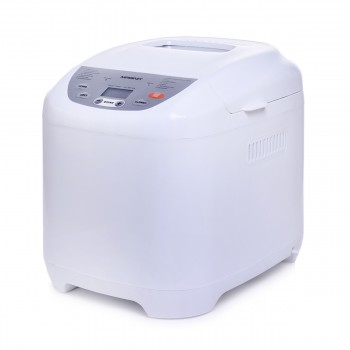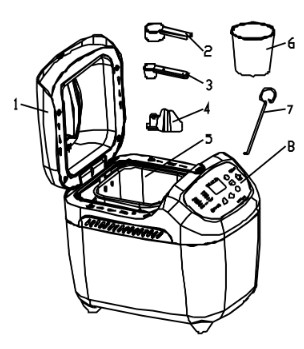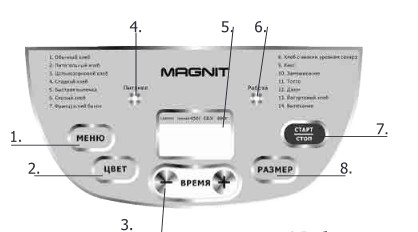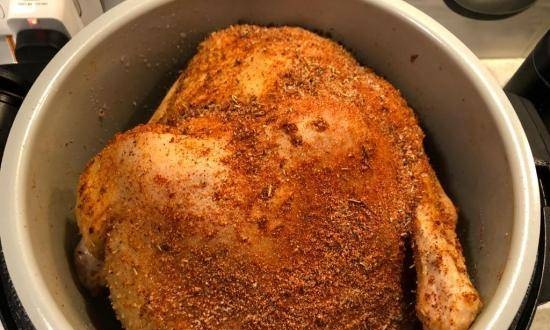Magnit RBM-1006. Description and characteristics of the bread maker |
|
Features of the Magnit RBM-1006 bread makerPower 720 W ProgramsNumber of baking programs 14 - Classic, French, Whole Grain, Sweet, Quick Bake, Quick Bread, French Loaf, Low Sugar Bread, Cupcake, Kneading, Dough, Jam, Yogurt, Bake Additional InformationNumber of kneaders 1 LCD display. Bread Maker Magnit RBM-10061. Cover with inspection hole
Control Panel1. Program selection
All ingredients used should be at ambient temperature (unless otherwise noted) and carefully weighed. Measure liquids using the supplied graduated beaker. Measure out liquids using the supplied measuring cup. Use a double dosing spoon, with a tablespoon and a teaspoon. Flour: the weight of flour is highly dependent on its type. Depending on the quality of the flour, the resulting baked goods may vary. Store flour in an airtight container, as it can react to fluctuations in temperature and humidity by absorbing or, conversely, releasing moisture. Preferably use so-called "strong", "bread" or "baking" flour rather than standard flour. Adding oat flour, bran, wheat germ, rye flour, and finally whole grains to the dough results in a heavier and less fluffy bread. The results are also influenced by how sifted the flour is - the more whole it is (that is, if it contains particles of the shell of wheat grains), the less the dough rises, and the denser the bread turns out. Yeast: Yeast provides a rise in the dough. Use active dry yeast in sachets. The quality of the yeast varies and does not always expand in the same way. Thus, the quality of the bread can vary depending on the yeast used. Old yeast or improperly stored yeast does not work as well as freshly opened dry yeast. All recipes are for dehydrated yeast. In case you are using fresh yeast, you should take a triple (by weight) amount of it and dilute it with a small amount of warm, slightly sugared water for its more effective action. Salt: Salt adds flavor to baked goods and helps regulate yeast activity. It should not come into contact with yeast. Thanks to the salt, the dough is firm, compact and does not rise very quickly. Salt also improves the texture of the dough. Fats and Vegetable Oil: Fats add fluffiness and flavor to bread. This bread also has a longer shelf life. Excess fat slows down the rise of the dough. If you are using butter, cut it into small pieces to distribute it more evenly in the dough, or soften it beforehand. Sugar: Sucrose, raw sugar, or honey is preferred. Never use refined sugar or lump sugar. Sugar nourishes the yeast, gives the bread flavor, and improves the browning color of the crust. Water: Water saturates and activates the yeast. It also saturates the starch in the flour and provides crumbling. Water can be replaced, in part or in whole, with milk or other liquids. Liquids should be at room temperature when added. Eggs: Eggs enrich the dough, improve the color of the bread and contribute to the formation of a tasty crumb. If using eggs, reduce the amount of liquid ingredients. Crack an egg and add liquids to the volume indicated for the liquid in the recipe. Recipes call for use of a 7-ounce medium egg; for larger eggs, add a little flour; for smaller eggs, reduce the amount of flour. Milk: You can use fresh or powdered milk. If using powdered milk, add water to the originally indicated volume. If you are using fresh milk, you can also add water - the total volume of liquid must be equal to the volume indicated in the recipe. Milk also has an emulsifying effect, which allows for more uniform cavities and a more beautiful crumb appearance. Additives: You can use your own recipes by adding any additives you want; in this case, however, it follows: |
| Magnit RBM-1005. Description and technical characteristics of the bread maker |
|---|
New recipes









